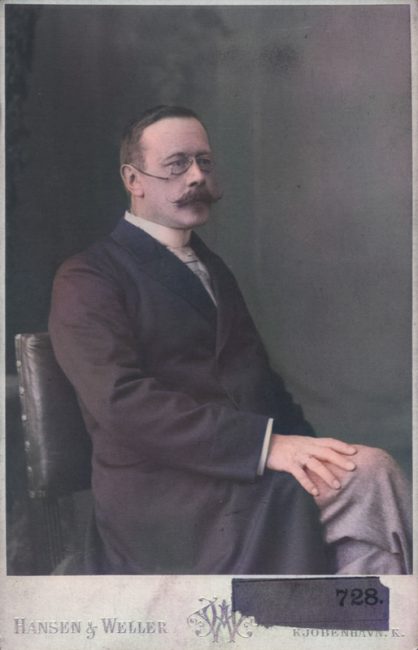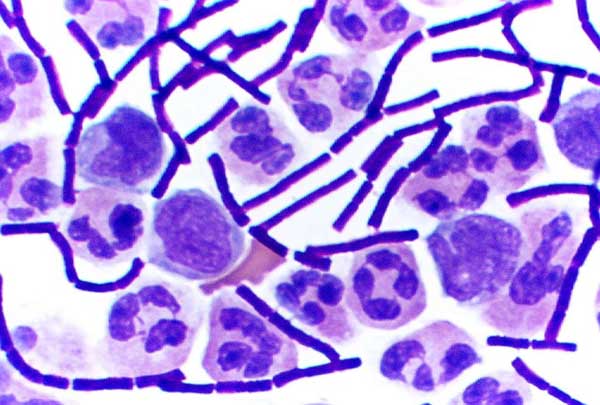
Hans Christian Gram (1855 – 1938)
On September 13, 1853, Danish bacteriologist Hans Christian Gram was born. Gram is best known for his development of the Gram stain, which differentiates bacteria by the chemical and physical properties of their cell walls by detecting peptidoglycan, which is present in a thick layer in gram-positive bacteria.
Hans Christian Gram – Youth and Education
Hans Christian Gram was the son of Frederik Terkel Julius Gram, a professor of jurisprudence, and Louise Christiane Roulund. In 1871, Gram studied botany at the University of Copenhagen and from 1873 to 1874 was an assistant in botany to the zoologist Japetus Steenstrup. His study of plants introduced him to the fundamentals of pharmacology and the use of the microscope. However, he soon developed an interest in medicine and entered medical school in 1878, where he graduated in 1883 and defended his doctoral thesis on the size of the human erythrocytes, the most common type of blood cell and the vertebrate organism’s principal means of delivering oxygen to the body tissues.
He travelled throughout Europe between 1878 and 1885, studying pharmacology and bacteriology. In 1891, Gram became a lecturer in pharmacology, and later that year was appointed professor at the University of Copenhagen. In 1900, he resigned his chair in pharmacology to become professor of medicine.
The Gram Stain
In Berlin, in 1884, he developed a method for distinguishing between two major classes of bacteria to make them more visible under a microscope. This technique, the Gram stain, continues to be a standard procedure in medical microbiology. While working with Friedländer in Berlin, he published his famous microbiological staining method. Gram experimented with staining pneumococci bacteria by modifying Ehrlich’s alkaline aniline solutions. Gram stained his preparations with aniline gentian violet, adding Lugol’s solution for from one to three minutes. When he then removed the nonspecific attributed stain with absolute alcohol, certain bacteria (pneumococci, for example) retained the color.[1]
Today, for the Gram stain, a slide containing a heat-fixed smear of bacterial cells is treated with crystal-violet stain during which the cells turn purple. The slide is then flushed with an iodine solution, followed by an organic solvent (such as alcohol or acetone). Gram-positive bacteria remain purple because they have a single thick cell wall that is not easily penetrated by the solvent; gram-negative bacteria, however, are decolorized because they have cell walls with much thinner layers that allow removal of the dye by the solvent. In a final step, a counterstain, such as safranin, is added and stains the gram-negative cells red.[2]
Gram was a modest man, and in his initial publication he remarked,
“I have therefore published the method, although I am aware that as yet it is very defective and imperfect; but it is hoped that also in the hands of other investigators it will turn out to be useful.”
Further Development of the Gram Stain
Hans Christian Gram only invented the first three parts of the Gram stain. The fourth part, counterstaining with safranin (or similar), did not happen for another few years, and was probably introduced by a German pathologist, Carl Weigert. It is actually quite extraordinary that a method invented 130 years ago is still a mainstay of diagnostic microbiology today.[3] Gram stains are performed on body fluid or biopsy when infection is suspected. Gram stains yield results much more quickly than culturing, and is especially important when infection would make an important difference in the patient’s treatment and prognosis; examples are cerebrospinal fluid for meningitis and synovial fluid for septic arthritis.
Final Years
Gram was among the first to recognise that macrocytes were characteristic of pernicious anaemia. In 1891, Gram became a lecturer in pharmacology, and was appointed professor at the University of Copenhagen. In 1900 he resigned his Chair in Pharmacology to become Professor of Medicine, where he published four volumes of clinical lectures which became widely used in Denmark. Gram retired in 1923 and died in 1938.
Vicki Symington, John Schollar, Microbiology Techniques: Gram staining [8]
References and Further Reading:
- [1] “Gram, Hans Christian Joachim.” Complete Dictionary of Scientific Biography. 2008.
- [2] Gram Stain at Britannica Online
- [3] “The man behind the Gram Stain”, at Microbiology matters, Mar 7, 2013.
- [4] Jay Hardy: Gram’s Serependitios Stain, at hardydiagnostics
- [5] Sergei Winogradsky and the Science of Bacteriology, SciHi blog
- [6] Jay Hardy. “Gram’s Serendipitous Stain”
- [7] Michallon, Clémence (13 September 2019). “Who was Hans Christian Gram and what did the groundbreaking scientist discover?”. Independent UK
- [8] Vicki Symington, John Schollar, Microbiology Techniques: Gram staining, Microbiology Society @ youtube
- [9] Hans Christian Gram at Wikidata
- [10] Timeline of Microbiologists, via Wikidata and DBpedia






